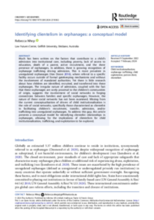Much has been written on the factors that contribute to a child’s admission into institutional care, including poverty, lack of access to education, death of a parent, active recruitment, and the sheer presence of orphanages. In addition, there is growing recognition of orphanage trafficking driving admission.
This is more prevalent in unregulated orphanages where referral to a specific facility occurs outside of formal gatekeeping mechanisms and without the involvement of mandated authorities. Yet there is little research about how children are identified, recruited, and transferred into these orphanages. The irregular nature of admission, coupled with the fact that these orphanages are rarely proximal to the children’s communities of origin, suggests the involvement of social networks in forging connections between families and specific orphanages. However, the nature of these social networks has not been examined. Missing from the current conceptualisation of drivers of child institutionalisation is the role of social networks, specifically those characterised as clientelist in facilitating children’s recruitment, transfer, admission, and/or trafficking into unregulated orphanages.
To address this gap, this article presents a conceptual model for identifying clientelist relationships in orphanages, allowing for the implications of clientelism for child institutionalisation, trafficking, and exploitation to be explored.

